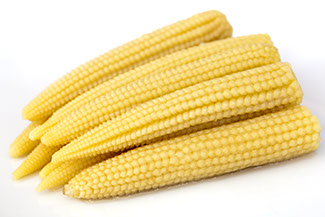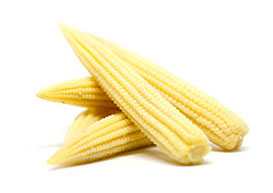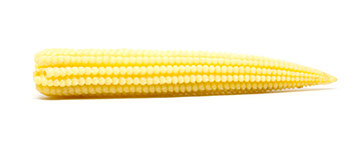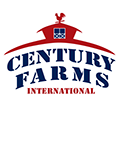
Overview
Compatibility & Temperature
Grade Tolerances
Nutrition Information
Baby Corn
Baby corn is a smaller version of regular-sized corn. Originally harvested in China, it is produced in many parts of Asia and Latin America and used throughout the world. Although there is only one type of baby corn, it can be processed in varying ways. Choosing what to get is often determined by freshness. The corn can be packaged fresh in plastic trays, processed in a metal can or glass jar, or frozen. Sometimes referred to as candle corn in Thailand, it is also found in various grades depending on size.
There are four grades of baby corns. The highest quality product is generally 1.6 to 2.8 inches (about 4 to 7 centimeters) long and is called Grade S. Grade T is the smallest, at less than 1.6 inches (4 centimeters) in length, while Grade L is the largest and Grade M is the second largest. You can choose baby corn based on the contents of the labeling. Details such as the variety, weight of the package, and the country it came from are often found on the product packaging.


Fresh corn often comes in plastic trays that are perforated for ventilation. The trays are sometimes arranged in 12 per carton for retail stores, but other packaging methods can be used for wholesale. Some supermarkets sell baby corn in glass jars, which usually cost more but are often preserved in a brine solution. When it is canned, the corn is usually in either 15 or 20 ounce (about 425 or 567 gram) packages, while 108 ounce (about 3.06 kilogram) containers are often used for exporting baby corn.
Choosing baby corn is generally based on freshness. Some varieties of corn, however, have more sweetness than others. The nutritional value is mostly the same for all of them, and similar to tomato, cabbage, and cauliflower. Baby corn grows in moist soil in areas where rainfall is abundant, and is generally harvested within a few days of emerging. Pesticides are usually not applied to the crops, so there is typically no concern about consuming harmful substances when eating the corn.
You can choose the type of baby corn based on whether it is for personal consumption, you run a food store, or work as an exporter. The size, type, and labeling are usually good for determining which is best. Factory operators can decide what to use by selecting the best grade for production.

Nutrition Facts
Serving Size 1 ear
Amount Per Serving
Calories from Fat 1Calories 6
% Daily Values*
Total Fat 0.08g 0%
Saturated Fat 0.012g 0%
Polyunsaturated Fat 0.038g
Monounsaturated Fat 0.023g
Cholesterol 0mg 0%
Sodium 17mg 1%
Potassium 16mg
Total Carbohydrate 1.49g 0%
Dietary Fiber 0.2g 1%
Sugars 0.28g
Protein 0.21g
Vitamin A 3% Vitamin C 23%
Calcium 1% Iron 8%
* Percent Daily Values are based on a 2000 calorie diet. Your daily values may be higher or lower depending on your calorie needs.
Nutrition Values are based on USDA Nutrient Database SR18

Century Farms International, Inc.
10957 NW 123rd Street Medley, FL 33178
Office: 305-436-7971 Fax: 305-436-7968



